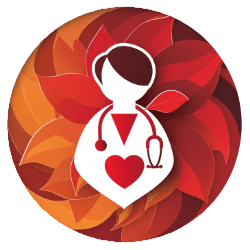Have you ever considered how a simple breath can be a powerful tool in managing your stress? As a nurse, you're constantly facing high-stress situations that can take a toll on your mental and physical health. It's vital to have practical techniques at your disposal to navigate these challenges.
The 4-7-8 breathing method, developed by Dr. Andrew Weil, is just one example of how you can regain control and alleviate stress quickly. This technique, alongside six others like Diaphragmatic Breathing and Alternate Nostril Breathing, offers a variety of options tailored to different needs and preferences.
By incorporating these breathing exercises into your daily routine, you're not just improving your ability to handle stress; you're also enhancing your overall well-being. Let's explore how each method can be seamlessly integrated into your hectic schedule, offering you a moment of peace in the midst of chaos.
Key Takeaways
- Diaphragmatic breathing activates the parasympathetic nervous system and reduces stress levels.
- Practicing the 4-7-8 breathing method lowers heart rate, blood pressure, and aids in falling asleep faster.
- Alternate nostril breathing improves focus, energy levels, and sense of purpose.
- Equal breathing harmonizes inhalation and exhalation, promotes calm, and enhances overall well-being.
Diaphragmatic Breathing
As a nurse, incorporating diaphragmatic breathing into your routine can significantly reduce stress, helping you maintain calm and focus during your shifts. This technique involves taking deep, slow breaths that fully engage your diaphragm, a practice that not only promotes relaxation but also activates the parasympathetic nervous system.
By doing so, you're essentially signaling to your body that it's time to unwind, leading to a decrease in heart rate, blood pressure, and cortisol levels. This not only aids in managing the stress inherent in your job but also fosters a sense of calm that's invaluable in the fast-paced, often unpredictable healthcare environment.
The beauty of diaphragmatic breathing lies in its simplicity and the profound impact it can have on your well-being. Regular practice can significantly improve your focus, allowing you to provide the best care possible to those who depend on you. It's a gentle reminder that taking care of yourself is paramount to effectively serving others.
4-7-8 Breathing Method
You'll find the 4-7-8 breathing method, developed by Dr. Andrew Weil, to be a remarkably simple yet powerful tool for managing stress and improving your sleep quality. This technique, known to lower heart rate and blood pressure, can significantly reduce stress levels and aid in falling asleep faster.
Here's how you can incorporate this method into your daily routine:
| Step | Duration (Seconds) | Purpose |
|---|---|---|
| Inhale | 4 | Gently fill your lungs with air |
| Hold | 7 | Allow the oxygen to circulate |
| Exhale | 8 | Release all the tension and stress |
Practicing the 4-7-8 breathing method twice a day will optimize its benefits. Whether your eyes are open during a hectic shift or closed in the quiet of your room, this technique is versatile and effective. Regular practice enhances its effectiveness, allowing you to better serve others while taking care of your well-being. Remember, mastering breathing techniques is a journey towards reducing stress and achieving inner peace.
Alternate Nostril Breathing
Moving from the simplicity of the 4-7-8 breathing method, let's explore another powerful technique: Alternate Nostril Breathing, known for its ability to balance and calm the mind. This practice, deeply rooted in ancient traditions, is one of the breathing exercises that can be a game-changer in managing your stress levels, especially in the demanding world of nursing.
Here's how you can do it: Sit comfortably, with your back straight and shoulders relaxed. Close your right nostril with your thumb and inhale deeply through your left nostril. Then, close your left nostril with your fingers, release your right nostril, and exhale slowly. Inhale through the right nostril, close it, and exhale through the left. This completes one cycle. Aim for 5 to 10 cycles whenever you need a moment of calm.
Alternate Nostril Breathing doesn't just reduce stress; it also improves your focus and energy levels, making it easier to care for others with a renewed sense of purpose.
In moments of overwhelm, remember that these breathing exercises are a tool for you to regain balance and peace, empowering you to be your best self, both for you and those you serve.
Progressive Relaxation Technique
As a nurse, you're constantly on your feet, dealing with high-stress situations that can take a toll on your body and mind.
The Progressive Relaxation Technique offers you a way to unwind by focusing on tensing and then relaxing your muscles, step by step.
It's not only a practical method to ease stress and anxiety but also improves your sleep and overall well-being, making it a valuable tool in your self-care arsenal.
Benefits for Nurses
Nurses often face high levels of stress and physical tension, but incorporating the progressive relaxation technique into their routine can significantly lower these pressures. Here's how you'll benefit:
- Alleviates Anxiety: It reduces symptoms such as an increased heart rate and high blood pressure, helping you manage stress more effectively.
- Promotes Better Patient Care: By lowering your stress levels, you're in a better position to provide compassionate and attentive care.
- Easy to Integrate: This technique fits seamlessly into your busy schedule, offering a practical way to handle job stress.
- Enhances Mental Clarity: With reduced stress levels and a lower heart rate, you'll find your mental clarity improves, making it easier to tackle challenges head-on.
Embrace this technique to not only care for others but also to take care of yourself.
Step-by-Step Guide
Understanding the benefits of reducing stress and enhancing mental clarity, let's explore the progressive relaxation technique through a step-by-step guide designed specifically for you.
First, find a quiet and comfortable place where you can sit or lie down undisturbed.
Begin by tensing and then relaxing each muscle group, starting from your toes and working your way up to your head.
As you release the tension in each muscle group, take slow, deep breaths to further enhance your relaxation.
Focus on the sensation of relaxation that sweeps through each muscle group.
If necessary, repeat the process to achieve a deeper state of relaxation.
This breathing technique is a practical tool in your toolkit for self-care, allowing you to serve others from a place of renewed strength and calm.
Box Breathing Practice
Box breathing, a simple yet powerful technique, involves breathing in, holding, breathing out, and holding again, each for four seconds, offering nurses a discreet and effective way to manage stress on the job. This practice not only helps regulate your nervous system but also fosters relaxation, making it an indispensable tool for those moments when the demands of nursing become overwhelming.
Here's how to incorporate the box breathing practice into your daily routine:
- Inhale deeply through your nose for four seconds, allowing your lungs to fill completely.
- Hold your breath for four seconds, experiencing the stillness and fullness within.
- Exhale slowly through your mouth for four seconds, releasing all the air and tension.
- Hold your breath again for four seconds, creating a moment of calm before beginning the next cycle.
Sama Vritti (Equal Breathing)
Transitioning from the structured rhythm of box breathing, let's explore Sama Vritti, or Equal Breathing, a technique that harmonizes your breath's inhalation and exhalation to foster tranquility and balance.
As you serve others tirelessly, finding moments for self-care through simple practices like Equal Breathing can be a game-changer in managing stress.
This method involves inhaling and exhaling through the nose for an equal count of 4, 6, or 8, depending on what feels most comfortable for you. It's a flexible tool you can use in any setting, whether you're charting at a desk or taking a brief moment in a quiet corner of your workspace.
Engaging in Equal Breathing helps regulate your nervous system, promoting a sense of calm that's essential in the fast-paced environment you navigate daily. It sharpens your mental focus, enabling you to provide the best care possible, while also reducing stress and enhancing your overall well-being.
Incorporating regular practice of Sama Vritti into your routine can significantly manage your stress levels, offering a pathway to inner peace amidst the demands of your profession. Remember, nurturing yourself allows you to continue nurturing others effectively.
Guided Visualization Breathing
Let's explore how Guided Visualization Breathing can be a game-changer for your mental health, especially after those long, taxing shifts.
By visualizing calm places, like a serene beach or a tranquil forest, while focusing on your breathing, you're not just relaxing; you're actively reducing stress and anxiety.
We'll also walk through some practical steps to integrate this technique into your daily routine, making relaxation more accessible than ever.
Benefits on Mental Health
Guided visualization breathing offers a powerful tool for nurses, helping you reduce stress and improve your mental health by calming the mind and easing physical tension. By nurturing a practice that focuses on deep, controlled breaths paired with visualizing tranquil scenes, you're not just coping with immediate stressors; you're also investing in your long-term well-being.
Here's how it benefits your mental health:
- Sends relaxing signals to your nervous system, reducing anxiety.
- Lowers heart rate and blood pressure, fostering a sense of peace.
- Enhances mental clarity, equipping you to provide better patient care.
- Strengthens your immune system by alleviating stress, which in turn, boosts your mental resilience.
Embrace guided visualization breathing as your go-to strategy for maintaining your mental health amidst the challenges of nursing.
Visualizing Calm Places
Building on the foundation of how guided visualization breathing enhances your mental health, it's essential to explore how visualizing calm places can further alleviate stress and improve your well-being.
By imagining serene environments, like a tranquil beach or a lush forest, you can transport your mind to a peaceful setting. This practice not only fosters a sense of calmness but also encourages deep breathing, which can help reduce stress significantly.
Engaging in this technique can enhance your mental clarity and promote overall well-being, making it easier to provide attentive care to your patients.
Practical Implementation Steps
To start incorporating guided visualization breathing into your routine, you'll first need to find a quiet, comfortable space where you won't be interrupted.
- Close your eyes and take deep, slow breaths. Focus on the air moving in and out of your lungs.
- Visualize a calm place. It could be a beach, a garden, or any place that brings you peace.
- Concentrate on the details of your calm place – the sounds, the smells, the sensations.
- With each breath, imagine the stress and physical symptoms of your day melting away.
Frequently Asked Questions
What Is a Breathing Technique That Helps With Stress?
A simple technique to ease stress involves deep breathing: inhale slowly for four counts, then exhale for six counts. Repeat this five times. It's effective, lowering your stress and physical tension without needing much time.
What Is the Breathing Technique for Nurses?
You're seeking a breathing technique tailored for nurses. The pause breathing method, involving deep inhalation, a pause to acknowledge feelings, and a slow exhale, is highly effective in reducing stress while on duty.
How to Use the 4-7-8 Breathing Technique to Reduce Stress?
To reduce stress, you'll love how the 4-7-8 breathing technique works. Inhale for four seconds, hold for seven, then exhale for eight. It's simple, effective, and you can do it anywhere. Give it a try!
What Is the Best Breathing Technique to Calm Down?
To calm down quickly, you'll find the 4-7-8 breathing technique most effective. It's simple: breathe in for 4, hold for 7, and exhale for 8. It'll help you relax and refocus in no time.





